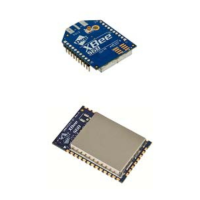XBee / XBee-PRO networks
XBee / XBee-PRO RF Modules 802.15.4 Product Manual 25
Figure 9: Peer-to-peer Architecture
A peer-to-peer network can be established by configuring
each module to operate as an End Device (CE = 0),
disabling End Device Association on all modules (A1 = 0)
and setting ID and CH parameters to be identical across
the network.
NonBeacon (with coordinator)
A device is configured as a Coordinator by setting the CE (Coordinator Enable) parameter to “1”.
Coordinator power-up is governed by the A2 (Coordinator Association) parameter.
In a Coordinator system, the Coordinator can be configured to use direct or indirect transmissions. If
the SP (Cyclic Sleep Period) parameter is set to “0”, the Coordinator will send data immediately.
Otherwise, the SP parameter determines the length of time the Coordinator will retain the data
before discarding it. Generally, SP (Cyclic Sleep Period) and ST (Time before Sleep) parameters should
be set to match the SP and ST settings of the End Devices.
Association
Association is the establishment of membership between End Devices and a Coordinator. The
establishment of membership is useful in scenarios that require a central unit (Coordinator) to relay
messages to or gather data from several remote units (End Devices), assign channels or assign PAN
IDs.
An RF data network that consists of one Coordinator and one or more End Devices forms a PAN
(Personal Area Network). Each device in a PAN has a PAN Identifier [ID (PAN ID) parameter]. PAN IDs
must be unique to prevent miscommunication between PANs. The Coordinator PAN ID is set using
the ID (PAN ID) and A2 (Coordinator Association) commands.
An End Device can associate to a Coordinator without knowing the address, PAN ID or channel of the
Coordinator. The A1 (End Device Association) parameter bit fields determine the flexibility of an End
Device during association. The A1 parameter can be used for an End Device to dynamically set its
destination address, PAN ID and/or channel.
For example: If the PAN ID of a Coordinator is known, but the operating channel is not; the A1
command on the End Device should be set to enable the ‘Auto_Associate’ and ‘Reassign_Channel’
bits. Additionally, the ID parameter should be set to match the PAN ID of the associated Coordinator.
Coordinator / End Device setup and operation
To configure a module to operate as a Coordinator, set the CE (Coordinator Enable) parameter to ‘1’.
Set the CE parameter of End Devices to ‘0’ (default). Coordinator and End Devices should contain
matching firmware versions.
NonBeacon (with Coordinator) systems
The Coordinator can be configured to use direct or indirect transmissions. If the SP (Cyclic Sleep
Period) parameter is set to ‘0’, the Coordinator will send data immediately. Otherwise, the SP
parameter determines the length of time the Coordinator will retain the data before discarding it.
Generally, SP (Cyclic Sleep Period) and ST (Time before Sleep) parameters should be set to match the
SP and ST settings of the End Devices.

